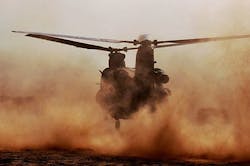Officials of the Technical Applications Contracting Office at Fort Eustis, Va., are awarding the contracts on behalf of U.S. Special Operations Command (SOCOM) at MacDill Air Force Base in Tampa, Fla. Contract winners are Rockwell Collins in Cedar Rapids, Iowa; the Boeing Co. Defense, Space & Security segment in Philadelphia; and Sierra Nevada Corp. in Sparks, Nev.
Engineers from Rockwell Collins, Boeing, and Sierra Nevada will develop the DVE System for Special Operations Command. The system sill integrate information from aircraft sensors to increase situational awareness for MH-47 and MH-60 helicopter aircrews. The contracts were announced last week.
Rockwell Collins won a $22.4 million contract, Boeing won a $23 million contract; and Sierra Nevada won a $22.6 million contract to develop the DVE System.
Based on wording of the contracts, the companies will not develop new sensors for coping with helicopter DVE, but instead will consolidate data from existing sensors onboard the MH-47 and MH-60 helicopters into a system to enhance pilot situational awareness.
Spatial disorientation (SD) describes flight incidents where the pilot fails to sense correctly the position, motion, or attitude of the aircraft as he loses sight of the ground, buildings, trees, other helicopters close by, and other outside visual cues in dust, snow, fog, smoke, or other obscurants.
Helicopters operating in dusty conditions, such as those in the Middle East and Southwest Asia, are particularly susceptible to DVE because the aircraft rotors kick up dense, choking clouds of dust so thick that pilots often cannot see beyond their own windshields. This condition is called brownout. When it happens in powdery snow it is called whiteout, but the effects are the same.
In the 15 years from 1990 to 2005 the SD crashes in the U.S. Air Force amounted to 11 percent of all crashes, according to the NATO Research and Technology Organization (RTO) report, "Spatial Disorientation Training –Demonstration and Avoidance."
In helicopters the problem is even worse. The U.S. Naval Aviation Center for Rotorcraft Advancement reports that three out of four helicopter accidents in Iraq and Afghanistan have been attributed to brownout conditions, and that more helicopters are lost to degraded visual environment (DVE) than to enemy fire. Moreover, DVE accidents have cost the U.S. armed forces more than $100 million annually, officials say.
Special Operations helicopters especially are vulnerable to DVE because they typically operate at night, and rarely have the option of cancelling crucial missions due to bad weather or other degraded-visibility conditions.
The awards to Rockwell Collins, Boeing, and Sierra Nevada are for technology demonstrations to run for five years. After that SOCOM officials may decided to pursue the program and choose one of the three contractors to develop a DVE-prevention system for deployment.
Last December SOCOM issued a request for information (H92241-12-R-0018) for the Degraded Visual Environment Pilotage System (DVEPS) program, which was to result in a multiple award cost plus fixed fee contract.
On these contracts Rockwell Collins will do the work in Cedar Rapids, Iowa; Boeing will do the work in Philadelphia; and Sierra Nevada will do the work in Sparks, Nev. All contractors will be finished by the end of 2017.
For more information contact Rockwell Collins online at www.rockwellcollins.com, Boeing Defense, Space & Security at www.boeing.com/boeing/bds, Sierra Nevada Corp. at www.sncorp.com, or SOCOM at www.socom.mil.



